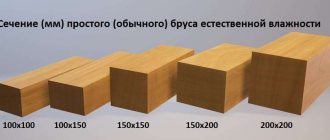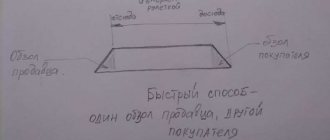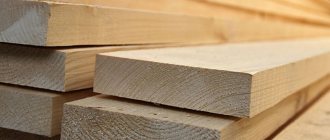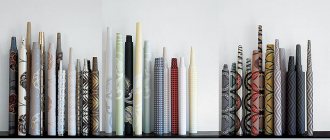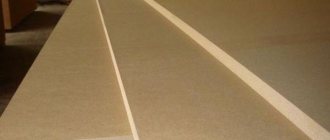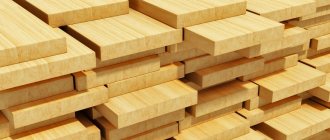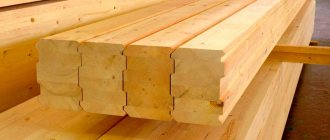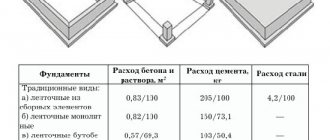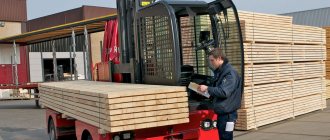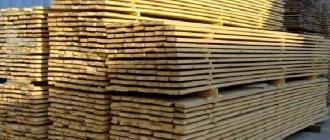Boards are a type of lumber with a narrow rectangular cross-section (usually more than two times the width of the thickness), which is made from beams or directly from logs, using a radial or tangential cut. Depending on the purpose, they are divided into edged and planed: the first are produced using simple technology and have many disadvantages (the surface is uneven, cracks are possible, excessive moisture), therefore they are suitable for rough floors, roofing, packaging, the second are of high quality (ideal geometry, polished surface , optimal humidity) and are used for finishing internal and external surfaces, furniture production.
The board calculator allows you to quickly calculate the number of pieces in a cube (cubic capacity) or perform a reverse calculation to calculate the volume of available materials. The tool also allows you to find out the total weight of lumber and the cost per unit. The calculator will be useful if you need to make an estimate with the amount of materials or choose a vehicle with a suitable carrying capacity for delivery. To get the calculation result, fill in the available fields and click the “ Calculate ” button. If you would like to use the tables, click here.
Features of counting the number of boards in a cube
In the building materials market, buyers are offered different types of boards. The number of pieces of boards in a cube depends on their type. The cube parameter itself is calculated equally for all materials, regardless of the type of board. The number of pieces will be influenced by the thickness, width and length of the material.
Timber, edged and unedged boards related to non-tongue and tongue building materials are calculated equally. All tongue and groove materials (lining, floor coverings, imitation timber) are calculated only according to the working width. The block house is calculated using the thickness parameters at the highest points.
How many boards and timber 3 m long in one cube - table
| Edged board 3 m | ||
| Size(mm) | Volume of one board (m3) | Number of boards in 1 cube (pcs.) |
| 20 mm | ||
| 20×100×3000 | 0,006 | 167 |
| 20×120×3000 | 0,008 | 139 |
| 20×150×3000 | 0,009 | 111 |
| 20×180×3000 | 0,01 | 93 |
| 20×200×3000 | 0,01 | 83 |
| 20×250×3000 | 0,02 | 66 |
| 25 mm | ||
| 25x100x3000 | 0,01 | 133 |
| 25x120x3000 | 0,01 | 111 |
| 25x150x3000 | 0,01 | 89 |
| 25x180x3000 | 0,01 | 74 |
| 25x200x3000 | 0,02 | 67 |
| 25x250x3000 | 0,02 | 45 |
| 30 mm | ||
| 30x100x3000 | 0,01 | 111 |
| 30x120x3000 | 0,01 | 93 |
| 30x150x3000 | 0,01 | 74 |
| 30x180x3000 | 0,02 | 62 |
| 30x200x3000 | 0,02 | 55 |
| 30x250x3000 | 0,02 | 44 |
| 40 mm | ||
| 40x100x3000 | 0,01 | 83 |
| 40x120x3000 | 0,01 | 70 |
| 40x150x3000 | 0,02 | 55 |
| 40x180x3000 | 0,02 | 46 |
| 40x200x3000 | 0,02 | 42 |
| 40x250x3000 | 0,03 | 33 |
| 50 mm | ||
| 50x100x3000 | 0,02 | 66 |
| 50x120x3000 | 0,02 | 55 |
| 50x150x3000 | 0,02 | 44 |
| 50x180x3000 | 0,03 | 37 |
| 50x200x3000 | 0,03 | 33 |
| 50x250x3000 | 0,04 | 27 |
| Beam 3 m | ||
| Size(mm) | Volume of one beam (m3) | Quantity of timber in 1 cube (pcs.) |
| 25x50x3000 | 0,0037 | 266 |
| 30x40x3000 | 0,0036 | 277 |
| 30x50x3000 | 0,0045 | 222 |
| 40x40x3000 | 0,0048 | 208 |
| 50x50x3000 | 0,0075 | 133 |
| 50x70x3000 | 0,01 | 95 |
Calculation of the number of pieces of board in a cube
To correctly calculate how many boards are in a cube, you need to multiply the length, width and height. Using the same principle, the cubic capacity of 1 piece of board is calculated. In this case, all parameters are converted to meters. For example, to find out the cubic capacity of a board measuring 25 X 150 X 6000 mm, you must first convert all the data into meters: 0.025 X 0.15 X 6 m. Now these data are multiplied, the cubic meter of one board is 0.0225. To find out how many pieces of boards are in a cube, you need to divide 1 cubic meter by the cubic meter of one board. In our example it looks like this:
1 cube / 0.0225 = 44.44 pieces
If the cubic meter of one board is larger, for example, like a timber, then the number of pieces of board in one cube will be less. Knowing how many boards are in a cube, you can calculate the cost of one piece. For example, the cost of a cubic meter is 6 thousand rubles. There are 44 boards in one cube. One board will cost:
6000 rub / 44 pcs = 136 rub.
Knowing this, it is easy to calculate not only the required number of cubic meters of material for the work, but also to find out how much the required number of boards will cost. To simplify the calculations, there are tables and calculators for calculating the number of boards in a cube. They are easy to use. Knowing the dimensions: thickness, length and width of the lumber, you can quickly make all the necessary calculations. Calculations for unedged lumber are carried out a little differently. To calculate a cubic meter, average values are taken. For example, the width of the board at one end is 15 cm, and at the other - 20 cm. The average width is 17 cm. It is this parameter that is taken into account when calculating the number of pieces using the formula, applying a coefficient from 0.7 to 0.9, depending on the gap between the boards formed when stacking.
Classification and characteristics of lumber
The very name “lumber” suggests that this type of construction raw material is obtained by longitudinal sawing of tree trunks on circular or band saws. Several cutting methods are used to produce boards and timber:
- tangential (in a circle),
- radial.
Tangential cutting involves moving the saw tangentially to the annual rings of the tree, which reduces the amount of waste and, therefore, reduces the cost of building materials. The boards obtained in this way have a beautiful, pronounced pattern, therefore they are often used for finishing purposes. Disadvantages of circular sawing include the tendency of the wood to shrink and swell, as well as a significant difference in texture as the cutting tool approaches the center of the log.
In the sawmill industry, several methods are used for sawing a trunk.
With radial sawing, the cutting line passes through the core of the tree, so the yield of boards will be smaller, and their price will be higher. However, if it is necessary to obtain high-quality wood, this method is used. This is due to the fact that, compared to the tangential method, radial sawing boards have halved swelling and shrinkage rates. In addition to the cutting methods discussed above, a mixed method is also used, which combines the advantages of the first two.
The concept of lumber actually includes not only traditional timber, which is most often seen in construction markets. The full list of products obtained from sawing logs includes:
- board;
- beam;
- bar;
- lagging;
- croaker
The last two types of lumber are classified as waste, which absolutely does not prevent them from being used for certain types of construction work, as well as for finishing purposes.
Boards
Boards include rectangular lumber with a thickness of no more than 100 mm and a width to thickness ratio of at least 2:1. Depending on the degree of processing, the board can be edged or unedged. The first is a finished product without bark and with smoothly sawn edges, while the second is a “semi-finished product” removed directly from the saw frame.
The edged board has smooth edges and a constant width along the entire length of the lumber
The most commonly used boards in construction are the following standard sizes:
- thickness - 25 mm, 40 mm, 50 mm, 60 mm;
- width - from 75 to 275 mm with gradation every 25 mm;
- length - from 1 m to 6.5 mm in increments of 250 mm.
Boards of other sizes can be obtained by trimming or planing standard lumber, as well as by placing an individual order for sawing round timber.
Unedged boards have a lower cost, but without finishing, their scope of application is limited
The parameters of lumber used in construction are standardized and determined according to the current GOST 8486–86 for coniferous wood and GOST 2695–83 for hardwood.
timber
Timber is lumber whose cross-section is a square with sides of at least 100 mm. The diameter of the timber is unified and can vary from 100 to 250 mm in increments of 25 mm. The standard defines the length of products of this type from 2 to 9 m, but most often square-section lumber with a length of no more than 6 m is used. In some cases, products with a cross-section of 150x100 mm, 200x100 mm or 200x150 mm, which according to the existing classification are much closer, are mistakenly classified as timber to the sleepers.
Timber is an ideal material for the construction of frames and other wooden structures
Bruschi
The bar differs from the beam discussed above only in that its cross-section does not exceed 100x100 mm. The typical length of the bar is also 6 m, and the diameter ranges from 40 mm to 90 mm in increments of 10 mm. To simplify the classification, bars are often classified as slats with a rectangular cross-section and a thickness-to-width ratio of at least 1:2. The standard range of edges for softwood slats looks like this: 16, 19, 22, 25, 32, 40, 44, 50, 60, 75 mm. For hardwood lumber, products of increased width are additionally provided, and the product line itself looks like this: 19, 22, 25, 32, 40, 45, 50, 60, 70, 80, 90, 100 mm.
A variety of bars and slats allow you to strengthen and make any wooden structure as stable as possible.
Obapole and croaker
Obapol is the very first cut of a round timber, the outer surface of which remains untreated. Unlike obapol, croaker can have a cut on half of the second side or alternating treated and untreated areas on the bark side. The importance of obapol and slab in construction is secondary, since the unaesthetic appearance and reduced performance characteristics allow the use of lumber of this type only for auxiliary purposes. Most often, slab and obapol are used as fastening materials, as well as for the manufacture of formwork, sheathing or flooring for scaffolding. This material is also interesting as a decorative material for decorating walls, fences and other vertical structures.
Despite their external ugliness, croaker and obapole are widely used for minor construction tasks
Counting tables
There are tables that already show the number of boards per cubic meter, depending on their type. They take into account standard dimensions of lumber. Using such tables, you can easily calculate the required amount of building material to complete the work.
| Section size, mm | Length, mm | Number of boards in 1 cube |
| 25x100 | 6000 | 66.6 pcs. |
| 25x150 | 6000 | 44.4 pcs. |
| 25x200 | 6000 | 33.3 pcs. |
| 40x100 | 6000 | 41.6 pcs. |
| 40x150 | 6000 | 27.7 pcs. |
| 40x200 | 6000 | 20.8 pcs. |
| 50x100 | 6000 | 33.3 pcs. |
| 50x150 | 6000 | 22.2 pcs. |
| 50x200 | 6000 | 16.6 pcs. |
Number of boards and timber in 1 cube for 6 m lumber
| Edged board 6 m | ||
| Size(mm) | Volume of one board (m3) | Number of boards in 1 cube (pcs.) |
| 20 mm | ||
| 20x100x6000 | 0,012 | 83 |
| 20x120x6000 | 0,014 | 69 |
| 20x150x6000 | 0,018 | 55 |
| 20x180x6000 | 0,021 | 46 |
| 20x200x6000 | 0,024 | 41 |
| 20x250x6000 | 0,03 | 33 |
| 25 mm | ||
| 25x100x6000 | 0,015 | 66 |
| 25x120x6000 | 0,018 | 55 |
| 25x150x6000 | 0,022 | 44 |
| 25x180x6000 | 0,027 | 37 |
| 25x200x6000 | 0,3 | 33 |
| 25x250x6000 | 0,037 | 26 |
| 30 mm | ||
| 30x100x6000 | 0,018 | 55 |
| 30x120x6000 | 0,021 | 46 |
| 30x150x6000 | 0,027 | 37 |
| 30x180x6000 | 0,032 | 30 |
| 30x200x6000 | 0,036 | 27 |
| 30x250x6000 | 0,045 | 22 |
| 40 mm | ||
| 40x100x6000 | 0,024 | 41 |
| 40x120x6000 | 0,028 | 34 |
| 40x150x6000 | 0,036 | 27 |
| 40x180x6000 | 0,043 | 23 |
| 40x200x6000 | 0,048 | 20 |
| 40x250x6000 | 0,06 | 16 |
| 50 mm | ||
| 50x100x6000 | 0,03 | 33 |
| 50x120x6000 | 0,036 | 27 |
| 50x150x6000 | 0,045 | 22 |
| 50x180x6000 | 0,054 | 18 |
| 50x200x6000 | 0,06 | 16 |
| 50x250x6000 | 0,075 | 13 |
| Beam 6 m | ||
| Size(mm) | Volume of one beam (m3) | Quantity of timber in 1 cube (pcs.) |
| 50x50x6000 | 0,015 | 66 |
| 100x100x6000 | 0,06 | 16 |
| 100x150x6000 | 0,09 | 11 |
| 100x200x6000 | 0,12 | 8 |
| 150x150x6000 | 0,135 | 7 |
| 150x200x6000 | 0,18 | 5 |
| 150x300x6000 | 0,27 | 3 |
| 200x200x6000 | 0,24 | 4 |
Calculation of how many boards are 6 meters in a cube using an online calculator
Perhaps the easiest way (along with the lumber cubature table) for determining the exact value of the volume and number of wooden boards is an online calculator. It is a program with specified algorithms that allow you to calculate all the necessary values of lumber. This method makes it possible to calculate not only edged boards, but also other types of these products.
Note! In order to avoid the possibility of errors when calculating material using an online calculator, you should immediately indicate for which board the measurement is being used.
To avoid mistakes when calculating the material using an online calculator, you need to indicate for which board the measurement is being used.
The process itself is quite simple. First, you need to find a calculator on one of the specialized sites using the search bar of your browser. Next, you will need to enter the necessary indicators in the appropriate cells. The cube board calculator will do the calculations on its own.
This method is popular and allows you to quickly and accurately determine all the necessary values of lumber. When using the calculator, it is recommended to check the accuracy of the filling several times. In case of an error, the calculation will be performed incorrectly, which can lead to serious discrepancies in the final figures.
Lumber block, tables
The tables show approximate values for the amount of lumber in pieces and linear meters per 1 cubic meter.
The material indicated in the tables is for informational purposes only. Values are rounded and actual lumber quantities may vary.
How many boards in a cube (edged or planed), up to 6 meters
Dimensions Number of pieces in one cubic meter. Number of linear meters in one cubic meter.
| 25x100x2000 | 200 | 400 |
| 25x100x4000 | 100 | 400 |
| 25x100x6000 | 66,67 | 400 |
| 25x150x2000 | 133,33 | 266,67 |
| 25x150x4000 | 66,67 | 266,67 |
| 25x150x6000 | 44,44 | 266,67 |
| 25x200x2000 | 100 | 200 |
| 25x200x4000 | 50 | 200 |
| 25x200x6000 | 33,33 | 200 |
| 40x100x2000 | 125 | 250 |
| 40x100x4000 | 62,5 | 250 |
| 40x100x6000 | 41,67 | 250 |
| 40x150x2000 | 83,33 | 166,67 |
| 40x150x4000 | 41,67 | 166,67 |
| 40x150x6000 | 27,78 | 166,67 |
| 40x200x2000 | 62,5 | 125 |
| 40x200x4000 | 31,25 | 125 |
| 40x200x6000 | 20,83 | 125 |
| 50x100x2000 | 100 | 200 |
| 50x100x4000 | 50 | 200 |
| 50x100x6000 | 33,33 | 200 |
| 50x150x2000 | 66,67 | 133,33 |
| 50x150x4000 | 33,33 | 133,33 |
| 50x150x6000 | 22,22 | 133,33 |
| 50x200x2000 | 50 | 100 |
| 50x200x4000 | 25 | 100 |
| 50x200x6000 | 16,67 | 100 |
How much timber is in a cube, size up to 12 meters
Dimensions Number of pieces in one cubic meter. Number of linear meters in one cubic meter.
| 100x100x3000 | 33,33 | 100 |
| 100x150x3000 | 22,22 | 66,67 |
| 100x160x3000 | 20,83 | 62,5 |
| 120x150x3000 | 18,52 | 55,56 |
| 120x160x3000 | 17,36 | 52,08 |
| 100x200x3000 | 16,67 | 50 |
| 150x200x3000 | 11,11 | 33,33 |
| 150x150x3000 | 14,81 | 44,44 |
| 200x200x3000 | 8,33 | 25 |
| 100x100x6000 | 16,67 | 100 |
| 100x150x6000 | 11,11 | 66,67 |
| 100x160x6000 | 10,42 | 62,5 |
| 120x150x6000 | 9,26 | 55,56 |
| 120x160x6000 | 8,68 | 52,08 |
| 100x200x6000 | 8,33 | 50 |
| 150x200x6000 | 5,56 | 33,33 |
| 150x150x6000 | 7,41 | 44,44 |
| 200x200x6000 | 4,17 | 25 |
| 100x100x9000 | 11,11 | 100 |
| 100x150x9000 | 7,41 | 66,67 |
| 100x160x9000 | 6,94 | 62,5 |
| 120x150x9000 | 6,17 | 55,56 |
| 120x160x9000 | 5,79 | 52,08 |
| 100x200x9000 | 5,56 | 50 |
| 150x200x9000 | 3,7 | 33,33 |
| 150x150x9000 | 4,94 | 44,44 |
| 200x200x9000 | 2,78 | 25 |
| 100x100x12000 | 8,33 | 100 |
| 100x150x12000 | 5,56 | 66,67 |
| 100x160x12000 | 5,21 | 62,5 |
| 120x150x12000 | 4,63 | 55,56 |
| 120x160x12000 | 4,34 | 52,08 |
| 100x200x12000 | 4,17 | 50 |
| 150x200x12000 | 2,78 | 33,33 |
| 150x150x12000 | 3,7 | 44,44 |
| 200x200x12000 | 2,08 | 25 |
Types of laminated timber profiles
How many rounded logs are in a cube, up to 9 meters
Dimensions Number of pieces in one cubic meter. Number of linear meters in one cubic meter.
| 150x3000 | 14,81 | 44,44 |
| 150x6000 | 7,41 | 44,44 |
| 150x9000 | 4,94 | 44,44 |
| 160x3000 | 13,02 | 39,06 |
| 160x6000 | 6,51 | 39,06 |
| 160x9000 | 4,34 | 39,06 |
| 180x3000 | 10,29 | 30,86 |
| 180x6000 | 5,14 | 30,86 |
| 180x9000 | 3,43 | 30,86 |
| 200x3000 | 8,33 | 25 |
| 200x6000 | 4,17 | 25 |
| 200x9000 | 2,78 | 25 |
| 220x3000 | 6,89 | 20,66 |
| 220x6000 | 3,44 | 20,66 |
| 220x9000 | 2,3 | 20,66 |
| 240x3000 | 5,79 | 17,36 |
| 240x6000 | 2,89 | 17,36 |
| 240x9000 | 1,93 | 17,36 |
| 250x3000 | 5,33 | 16 |
| 250x6000 | 2,67 | 16 |
| 250x9000 | 1,78 | 16 |
| 260x3000 | 4,93 | 14,79 |
| 260x6000 | 2,47 | 14,79 |
| 260x9000 | 1,64 | 14,79 |
| 280x3000 | 4,25 | 12,76 |
| 280x6000 | 2,13 | 12,76 |
| 280x9000 | 1,42 | 12,76 |
| 300x3000 | 3,7 | 11,11 |
| 300x6000 | 1,85 | 11,11 |
| 300x9000 | 1,23 | 11,11 |
tongue and groove
How can you calculate the cubic capacity of a tongue and groove flooring with your own hands?
Let's use common sense:
- A tongue and groove lock consists of a groove on one side of the product and a tongue on the other side. In this case, the dimensions of the groove and the ridge are equal to each other with a minimum error;
- Accordingly, we can simply discard the size of the tongue and neglect the groove, calculating the cubic capacity of a unit of lumber without a lock. To obtain m3 for one board, its working width is multiplied by thickness and length.
The shape of the product makes it possible to neglect the size of the tongue-and-groove lock.
How many boards are there in a cube of 6 meters: how to make calculations using various methods
Construction of a private house, cottage or any other building requires drawing up an estimate. It indicates the quantity of building materials and their cost. There are several methods that allow you to carry out the corresponding calculations. The board is a common material that is used everywhere. In order to determine how many boards are 6 meters in a cube , you need to familiarize yourself with the calculation options and the nuances of this process. Cube of timber: how to calculate, table, formula and calculation methods (read more)
How many boards are there in a cube of 6 meters: calculation of the cubic capacity of the board will depend on the degree of processing of the material, type and grade.
Volumes according to the cubic table
However, the average parameters of a conventional 1 piece should still be known, especially since the cubature itself is simple. All lumber is produced in fixed sizes. In our case, the standard length is 6 m, and the standard thickness options are 25, 40 and 50 mm. If the length is different, the volume is calculated in proportion to 6 meters. So, with a length of 6 m:
- thickness 25 mm – volume 0.0294 m³;
- 40 mm – 0.05 m³;
- 50 mm – 0.071 m³.
From here, by the way, it is easy to calculate that with a thickness of 25 mm the width on average is approximately 19 cm, with 40 - about 21 cm, with 50 - about 23 cm. This is logical: thicker boards are usually made from logs of larger diameter.
How to use the cubic capacity calculator correctly
The program for calculating the cubic capacity of timber and boards is a convenient tool for easily and accurately calculating the number or volume of boards. Our m3 lumber calculator is very easy to use and does not require special knowledge of how to use it. To correctly calculate the timber for a house or to perform other tasks, you should follow a few simple steps:
- indicate the main parameters of the board – length, height, width;
- select the required type of calculation - by the number of timber/boards or by volume;
- indicate the quantity or volume of timber/boards and the price of lumber by checking the box next to “price per 1 cubic meter” or “price per 1 board”, write down the weight of the board;
- review the calculation results.
Our calculator for timber for floors, ceilings or for using lumber for other purposes carries out calculations without taking into account the gaskets. Pay attention to this nuance!
To quickly access the thermal insulation calculator, press Ctr+D on your keyboard and the calculator will be in your bookmarks!
Types and types of boards
If you ask an uninitiated layman a question, what is a board? He won't answer at all. But in fact, there is a scientific definition for this material: A board is lumber whose width exceeds its thickness, and this is a significant difference from timber.
Boards come in different thicknesses, widths, lengths and are divided into two types.
- The board is uncut. Boards that have not yet had an edge cut off on at least one side. They are well suited for sheathing, building a fence, a shed and other important, but inconspicuous structures and structures.
- Edged board. These boards are completely ready for construction and installation work. All sides of such a board are carefully processed, all edges are cut.
In addition to the standard division, boards are divided into two types: carpentry board and fence board.
- A joiner's board is a type of board from which household items, flooring are made, lining and other decorative products are made from such boards. As a rule, boards of this type are distinguished by the absence of knots and their strength. These are boards of the first category.
- Fence board is a type of lumber for simple construction work or rough work. Such boards have defects in the form of visible and invisible knots. This material is much cheaper. These are boards of the second and third categories.
